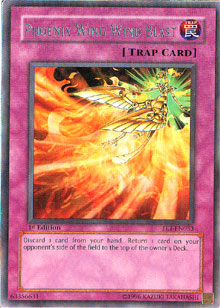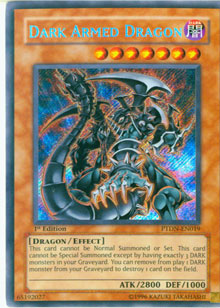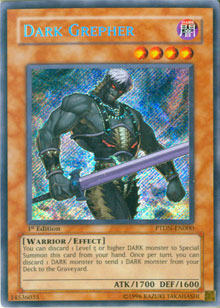 I, for one, am shocked.
I, for one, am shocked.
While I expected a lot of surprises coming out of Shonen Jump Championship Nashville, the return of Phoenix Wing Wind Blast in huge numbers was not on my guess list. I expected Wind Blast to make an impressive comeback: it just happened two weeks earlier than I thought it would. A whopping seven competitors in the Top 16 at Nashville played Phoenix Wing Wind Blast—five of them were Shonen Jump Champions. Wind Blast proved to be a very strong choice for the Nashville metagame for a number of reasons, most of which I detailed in the weekend’s Tech Update. It sent Light and Darkness Dragon running, provided versatile spot removal of whatever was giving a duelist trouble, and even took out popular picks like Zombie Master and Great Shogun Shien—cards that saw a big surge in play but didn’t make it to Day 2.
But that’s all in the past, and if you read the tournament coverage, you already knew why Phoenix Wing Wind Blast was successful tech at Nashville. Today I want to look at the expectations that led me to believe Wind Blast would be successful after Nashville: the metagame trends and tactical points that will make Wind Blast a strong choice for anyone heading to Shonen Jump Championship St. Louis this weekend. I want to do that by looking at what I think are the three top matchups you should expect to see.

Dark Armed Dragon Control
With Lightsworn threatening Light and Darkness Dragon’s domination, we have to assume that Light and Darkness will see less play in St. Louis—we can’t really count that as a reason to play Wind Blast in the approaching metagame. But using Wind Blast to spin Dark Armed Dragon in response to the first use of its destruction/removal effect has always been a good move, often leaving your opponent topdecking the Dragon next turn with one too few Dark monsters in the graveyard. The removal of Dimension Fusion and Return from the Different Dimension has also made the Dragon’s actual ATK more important as a win condition, so just getting it out of the way and keeping it from wearing down your life points has become more important.
While the Dragon can be a dead topdeck once spun with Wind Blast, it’s certainly not the only dead draw in the matchup. Spinning Dark Magician of Chaos was always decent, but it’s an even better move these days thanks to Allure of Darkness’s addition to the Semi-Limited list. Short of discarding it for a cost or waiting on Allure, there’s usually nothing you can do with it. The drop-off in Light and Darkness’s popularity that I think we’ll see also means more table-time for Destiny Hero - Plasma, another monster that very easily becomes a useless draw when you stick it back on top of your opponent’s deck. Considering the huge reliance on monster effects that most decks in the post-Light of Destruction era are going to demonstrate, the ability to get rid of Plasma is tremendously valuable. Plasma saw a huge increase in play in Nashville, and it’s probably going to get more popular over the coming months.
 Since the Dragon is now more important, getting it to the field early is usually the difference between winning and losing. We saw this in Nashville, as more duelists than ever before were playing Dark Grepher with both of its effects in order to play Dark Armed Dragon very quickly. Phoenix Wing Wind Blast creates a problem for the Dark Armed duelist in that scenario. If your opponent special summons Dark Grepher, activates Grepher’s effect with priority, and doesn’t send the right monsters to the graveyard, he or she is now exposed to Torrential Tribute. If Torrential flips, then the Dark Armed player ends up with four Darks in the graveyard: if that player didn’t send Destiny Hero - Malicious to the graveyard with the second copy in deck, he or she won’t be able to drop Dark Armed.
Since the Dragon is now more important, getting it to the field early is usually the difference between winning and losing. We saw this in Nashville, as more duelists than ever before were playing Dark Grepher with both of its effects in order to play Dark Armed Dragon very quickly. Phoenix Wing Wind Blast creates a problem for the Dark Armed duelist in that scenario. If your opponent special summons Dark Grepher, activates Grepher’s effect with priority, and doesn’t send the right monsters to the graveyard, he or she is now exposed to Torrential Tribute. If Torrential flips, then the Dark Armed player ends up with four Darks in the graveyard: if that player didn’t send Destiny Hero - Malicious to the graveyard with the second copy in deck, he or she won’t be able to drop Dark Armed.
If your opponent can make the Malicious play (and knows how to do so) he or she is fine—but if the opponent doesn’t, and that player instead passes priority when Dark Grepher is summoned, then activating Wind Blast to spin Grepher away robs him or her of Dark Armed Dragon for the turn. The opponent loses the element of surprise, and you’ll get to prepare for his or her obvious Dark Armed play.
Since Dimension Fusion and Return from the Different Dimension were nerfed by the recent mid-format changes, Dark Armed Dragon decks are far more dependant on their big monsters in order to win. That makes the deck a prime target for Phoenix Wing Wind Blast, with or without Light and Darkness Dragon.
Lightsworn Beatdown
Wind Blast’s function in the Lightsworn matchup is different. Spinning the Dragon in this deck only delays the inevitable, since Judgment Dragon’s special summoning threshold is a lot more flexible than Dark Armed Dragon’s. Sure, activating Wind Blast to blow away Judgment Dragon may save you from certain death on occasion, but it won’t give you much of a tactical advantage.
Instead, a duelist playing Wind Blast will want to go after the little guys. Keeping Lightsworn monsters out of the graveyard is always a good thing, because it means one less checkmark on the list of "dudes my opponent needs in the ’yard to bring out Judgment Dragon." It also keeps Lumina, Lightsworn Summoner and Glorious Illusion from becoming too useful. Activating Wind Blast against a Lightsworn deck is no laughing matter (because you’re losing two cards to a deck that thrives in a simplified game state), but with the right targets it can be an incredibly good move.
My personal favorite is Wulf, Lightsworn Beast. Wulf is one of the few Lightsworn cards that can be a dead draw pretty regularly, and while having Wulf on the top of your deck is often a good thing, there are lots of situations where it isn’t. As a general (and obvious) rule, you don’t want to spin Wulf when you know your opponent might be able to send him from the deck to the graveyard. That means you don’t spin him if your opponent has an end-phase "send cards to the graveyard" monster (like Lyla, Lightsworn Sorceress or Ehren, Lightsworn Monk) in play, or if he or she might be able to get one to the field. The same goes for when the opponent has a set monster—it’s probably Ryko, Lightsworn Hunter, so flipping it after you spin Wulf would just special summon Wulf back to the field.
Instead, you want to spin Wulf in one of two situations. If it’s your turn, go ahead and spin him—your opponent can’t do anything between now and his or her draw phase unless you attack into Ryko. Spinning Wulf when he’s fresh off a special summon in your opponent’s end phase is viable too, but it usually isn’t necessary to make that commitment unless your opponent set Royal Decree this turn. The second ideal time to spin Wulf is when your opponent has already used his or her normal summon for the turn and doesn’t control an end-phase effect monster that would let the opponent bring out Wulf again.
I think it’s important to note that Wind Blast is one of the only ways to stop Ryko, Lightsworn Hunter as well. Sure, Judgment Dragon or Dark Armed Dragon could blow the little pup away, but those are huge plays to waste on a single flip-effect monster, and if you’re staring down Ryko on turn 1, they probably won’t be an option. A lot of people still seem to doubt the power of flip effects due to the speed that existed prior to the mid-format change, but I think those people are in for a rude awakening. Ryko is a huge threat, and any time a Lightsworn player can set it on turn 1, he or she is in very good shape.
The Lightsworn are all about synergy between their smaller monsters—without it, they can’t really use the big guys like Judgment Dragon or Celestia, Lightsworn Angel effectively. Break up the little guys early with Wind Blast, and you’ll find that you have the opportunity you need to deal with this difficult deck.

Gladiator Beasts
Gladiator Beast Murmillo is one of the deck’s smallest must-run monsters, and it tends to see a lot of table time hanging out in defense mode after it destroys something. Its small size makes it a poor topdeck though, and shunting it back to the deck can really slow down the Gladiator Beast strategy. Most Gladiator players won’t have any use for it short of setting it alongside Waboku, comboing it with Test Tiger, or using it with Gladiator Beast Bestiari to bring down Gladiator Beast Gyzarus. Murmillo’s pretty useless on its own.
 The same can be said for Gladiator Beast Secutor, a monster with even weaker stats and an even greater dependency on combos. A good Gladiator Beast player will probably never choose to end his or her turn with Secutor on the field, but an ambitious (or desperate) one may summon Secutor with Test Tiger if that player has Waboku: either to bait out an attack next turn or to make one, depending on when Waboku was set. In either scenario, Wind Blast shunts Secutor back to the top of the deck and devastates the next turn’s draw.
The same can be said for Gladiator Beast Secutor, a monster with even weaker stats and an even greater dependency on combos. A good Gladiator Beast player will probably never choose to end his or her turn with Secutor on the field, but an ambitious (or desperate) one may summon Secutor with Test Tiger if that player has Waboku: either to bait out an attack next turn or to make one, depending on when Waboku was set. In either scenario, Wind Blast shunts Secutor back to the top of the deck and devastates the next turn’s draw.
Speaking of Test Tiger, Wind Blast is brutal against it. If your opponent special summons the Tiger and tributes it for its effect, just spin away whichever Gladiator Beast your opponent was going to send back to the deck. Test Tiger’s effect targets one Gladiator Beast at activation, and if that monster leaves the field before the effect resolves, your opponent doesn’t get to special summon anything.
Finally, spinning Gladiator Beast Gyzarus in response to its effect is huge. It’ll keep Gyzarus from tagging out and bringing two more Gladiators into play, likely giving you an open field to swing into next turn. More importantly, Wind Blast sends Gyzarus back to the Fusion deck instead of destroying it like Raigeki Break would—that means your opponent won’t be able to special summon Gyzarus later through common means like Monster Reborn, Premature Burial, or Gladiator Beast Darius.
It’s Good in Other Matchups Too!
As good as Wind Blast is in the three big matchups I’m anticipating, it’s not just limited to use against those decks. It can be invaluable against Gadgets, giving you a way to get rid of Protector of the Sanctuary or Fossil Dyna Pachycephalo. That gives you one turn to use draw effects or make special summons, which is sometimes all you need to wrest control of the game from your opponent. Wind Blast can force a Counter Fairy player to play Solemn Judgment or Dark Bribe earlier than he or she had planned, by threatening Bountiful Artemis. There really isn’t a bad matchup for this card save Macro Cosmos, and with Macro having little real advantage over many of the decks we’ll see in this format (no, it doesn’t beat Lightsworn), it doesn’t seem like it will see serious play any time soon.
Phoenix Wing Wind Blast is one of those tactical cards that rewards experienced players, as well those duelists who just know all the rulings for the card and can make advantageous moves because of it. Frankly, if you weren’t a Wind Blast rulings guru before you read this article, you are now, so even if you’re relatively new to the Yu-Gi-Oh! TCG, you should be able to use Wind Blast effectively. It fits into virtually any deck, and with so many top strategies focusing on graveyard management, it’s a natural fit for a lot of the decks you might be playing already.
Try it for yourself—you’ll probably find that you have a distinct advantage in any metagame you set foot in over the coming weeks.
—Jason Grabher-Meyer